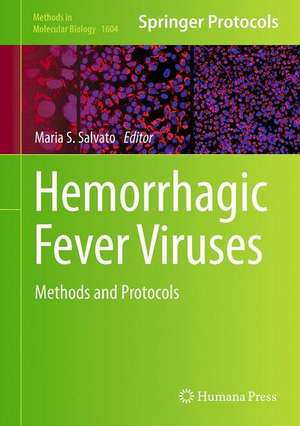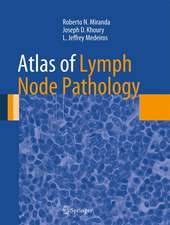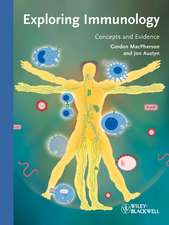Hemorrhagic Fever Viruses: Methods and Protocols: Methods in Molecular Biology, cartea 1604
Editat de Maria S. Salvatoen Limba Engleză Hardback – 7 oct 2017
Thorough and cutting-edge, Hemorrhagic Fever Viruses: Methods and Protocols is a valuable resource for scientists and researchers who want to bridge the gap between virus recognition in surveillance and understanding host responses to infection.
| Toate formatele și edițiile | Preț | Express |
|---|---|---|
| Paperback (1) | 765.36 lei 38-45 zile | |
| Springer – 22 aug 2018 | 765.36 lei 38-45 zile | |
| Hardback (1) | 1180.18 lei 6-8 săpt. | |
| Springer – 7 oct 2017 | 1180.18 lei 6-8 săpt. |
Din seria Methods in Molecular Biology
- 9%
 Preț: 791.63 lei
Preț: 791.63 lei - 23%
 Preț: 598.58 lei
Preț: 598.58 lei - 20%
 Preț: 882.98 lei
Preț: 882.98 lei -
 Preț: 252.05 lei
Preț: 252.05 lei - 5%
 Preț: 802.70 lei
Preț: 802.70 lei - 5%
 Preț: 729.61 lei
Preț: 729.61 lei - 5%
 Preț: 731.43 lei
Preț: 731.43 lei - 5%
 Preț: 741.30 lei
Preț: 741.30 lei - 5%
 Preț: 747.16 lei
Preț: 747.16 lei - 15%
 Preț: 663.45 lei
Preț: 663.45 lei - 18%
 Preț: 1025.34 lei
Preț: 1025.34 lei - 5%
 Preț: 734.57 lei
Preț: 734.57 lei - 18%
 Preț: 914.20 lei
Preț: 914.20 lei - 15%
 Preț: 664.61 lei
Preț: 664.61 lei - 15%
 Preț: 654.12 lei
Preț: 654.12 lei - 18%
 Preț: 1414.74 lei
Preț: 1414.74 lei - 5%
 Preț: 742.60 lei
Preț: 742.60 lei - 20%
 Preț: 821.65 lei
Preț: 821.65 lei - 18%
 Preț: 972.30 lei
Preț: 972.30 lei - 15%
 Preț: 660.49 lei
Preț: 660.49 lei - 5%
 Preț: 738.41 lei
Preț: 738.41 lei - 18%
 Preț: 984.92 lei
Preț: 984.92 lei - 5%
 Preț: 733.29 lei
Preț: 733.29 lei -
 Preț: 392.60 lei
Preț: 392.60 lei - 5%
 Preț: 746.26 lei
Preț: 746.26 lei - 18%
 Preț: 962.66 lei
Preț: 962.66 lei - 23%
 Preț: 860.22 lei
Preț: 860.22 lei - 15%
 Preț: 652.64 lei
Preț: 652.64 lei - 5%
 Preț: 1055.50 lei
Preț: 1055.50 lei - 23%
 Preț: 883.87 lei
Preț: 883.87 lei - 19%
 Preț: 491.89 lei
Preț: 491.89 lei - 5%
 Preț: 1038.86 lei
Preț: 1038.86 lei - 5%
 Preț: 524.16 lei
Preț: 524.16 lei - 18%
 Preț: 2122.34 lei
Preț: 2122.34 lei - 5%
 Preț: 1299.23 lei
Preț: 1299.23 lei - 5%
 Preț: 1339.12 lei
Preț: 1339.12 lei - 18%
 Preț: 1390.26 lei
Preț: 1390.26 lei - 18%
 Preț: 1395.63 lei
Preț: 1395.63 lei - 18%
 Preț: 1129.65 lei
Preț: 1129.65 lei - 18%
 Preț: 1408.26 lei
Preț: 1408.26 lei - 18%
 Preț: 1124.92 lei
Preț: 1124.92 lei - 18%
 Preț: 966.27 lei
Preț: 966.27 lei - 5%
 Preț: 1299.99 lei
Preț: 1299.99 lei - 5%
 Preț: 1108.51 lei
Preț: 1108.51 lei - 5%
 Preț: 983.76 lei
Preț: 983.76 lei - 5%
 Preț: 728.16 lei
Preț: 728.16 lei - 18%
 Preț: 1118.62 lei
Preț: 1118.62 lei - 18%
 Preț: 955.25 lei
Preț: 955.25 lei - 5%
 Preț: 1035.62 lei
Preț: 1035.62 lei - 18%
 Preț: 1400.35 lei
Preț: 1400.35 lei
Preț: 1180.18 lei
Preț vechi: 1242.30 lei
-5% Nou
Puncte Express: 1770
Preț estimativ în valută:
225.82€ • 236.63$ • 186.69£
225.82€ • 236.63$ • 186.69£
Carte tipărită la comandă
Livrare economică 11-25 aprilie
Preluare comenzi: 021 569.72.76
Specificații
ISBN-13: 9781493969807
ISBN-10: 1493969803
Pagini: 380
Ilustrații: XVI, 425 p. 61 illus., 52 illus. in color.
Dimensiuni: 178 x 254 mm
Greutate: 0.98 kg
Ediția:1st ed. 2018
Editura: Springer
Colecția Humana
Seria Methods in Molecular Biology
Locul publicării:New York, NY, United States
ISBN-10: 1493969803
Pagini: 380
Ilustrații: XVI, 425 p. 61 illus., 52 illus. in color.
Dimensiuni: 178 x 254 mm
Greutate: 0.98 kg
Ediția:1st ed. 2018
Editura: Springer
Colecția Humana
Seria Methods in Molecular Biology
Locul publicării:New York, NY, United States
Cuprins
Global Spread of Hemorrhagic Fever Viruses: Predicting Pandemics.- An Approach to the Identification and Phylogenetic Analysis of Emerging and Hemorrhagic Fever Viruses.- Preliminary Classification of Novel Hemorrhagic Fever-Causing Viruses Using Sequence-Based Pairwise Sequence Comparison (PASC) Analysis.- Epidemiological Surveillance of Viral Hemorrhagic Fevers with Emphasis on Clinical Virology.- Diagnostics for Lassa Fever: Detecting Host Antibody Responses.- Sampling Design and Mosquito Trapping for Surveillance of Arboviral Activity.- Epidemiological Surveillance of Rodent-Borne Viruses (Roboviruses).- Entry Studies of New World Arenaviruses.- Studies of Lassa Virus Cell Entry.- A Cell-Cell Fusion Assay to Assess Arenavirus Envelope Glycoprotein Membrane-Fusion Activity.- Assays to Assess Arenaviral Glycoprotein Function.- Expression and X-Ray Structural Determination of the Nucleoprotein of Lassa Fever Virus.- Assays to Demonstrate the Roles of Arenaviral Nucleoproteins (NP)in Viral RNA Synthesis and in Suppressing Type I Interferon.- Intracellular Detection of Viral Transcription and Replication using RNA FISH.- Hemorrhagic Fever Virus Budding Studies.- Murine Models for Viral Hemorrhagic Fever.- Testing Experimental Therapies in a Guinea Pig Model for Hemorrhagic Fever.- A Primate Model for Viral Hemorrhagic Fever.- A Primary Human Liver Cell Culture Model for Hemorrhagic Fever Viruses.- Protocol for the Production of a Vaccine Against Argentine Hemorrhagic Fever.- Detection of Virus-Antibody Immune Complexes in Secondary Dengue Virus Infection.- Future Approaches to DNA Vaccination Against Hemorrhagic Fever Viruses.- Identifying Restriction Factors for Hemorrhagic Fever Viruses: Dengue and Junín.- Determining the Virus Life-Cycle Stage Blocked by an Antiviral.- Retrovirus-Based Surrogate Systems for BSL-2 High-Throughput Screening of Antivirals Targeting BSL-3/4 Hemorrhagic Fever-Causing Viruses.- Protocols to Assess Coagulation following In Vitro Infection with Hemorrhagic Fever Viruses.
Textul de pe ultima copertă
This volume presents protocols that analyze and explore hemorrhagic fever viruses (HFV). This book is divided into 5 parts: Part I begins with an overview on predicting viral pandemics and then covers methods for surveillance, diagnosis, and classification of HFV. This includes an antibody capture method using Lassa virus antigens. Part II discusses structural studies and reverse genetics of HFV. The chapters in this part describe envelope glycoprotein membrane fusion studies, arenavirus nucleocapsid protein, and the use of virus-like-particles to study viral egress. Part III explores in vivo models of HFV infections, and contains chapters on murine, guinea pig, and primate models for HFV, and methods to obtain a subset of primary human liver cells that can be cultured long-term. Part IV looks into immune assays and vaccine production for HFV. The chapters in this section cover the attenuated vaccine for Argentine HFV, detecting virus-antibody immune complexes in secondary dengue infections, and DNA vaccination. Part V discusses host responses to viral hemorrhagic fever, and contains chapters on identifying host restrictions to Junín or Dengue infection, and a cell-culture method to assess coagulation after HFV infection. Written in the highly successful Methods in Molecular Biology series format, chapters include introductions to their respective topics, lists of the necessary materials and reagents, step-by-step, readily reproducible laboratory protocols, and tips on troubleshooting and avoiding known pitfalls.
Thorough and cutting-edge, Hemorrhagic Fever Viruses: Methods and Protocols is a valuable resource for scientists and researchers who want to bridge the gap between virus recognition in surveillance and understanding host responses to infection.
Thorough and cutting-edge, Hemorrhagic Fever Viruses: Methods and Protocols is a valuable resource for scientists and researchers who want to bridge the gap between virus recognition in surveillance and understanding host responses to infection.
Caracteristici
Includes cutting-edge methods and protocols Provides step-by-step detail essential for reproducible results Contains key notes and implementation advice from the experts Includes supplementary material: sn.pub/extras








